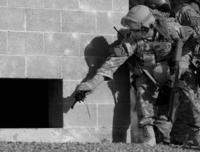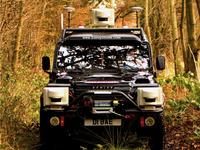-
TraceSpan Communications shows new interception device
DOCSIS Phantom intercepts target communications directly from the line and collects a hundred percent of the information in both directions, to and from the ISP or communications provider; the device allows interception of all data, including peer-to-peer communication, even when it does not pass through the ISP server
-
-
Rising political, economic tensions over critical minerals

The clean energy economy of the future hinges on many things, chief among them the availability of the scores of rare Earth minerals and other elements used to make everything from photovoltaic panels and cellphone displays to the permanent magnets in cutting edge new wind generators; trouble is, China currently controls about 97 percent of the mining and production of the minerals, and it is using that control to give Chinese companies an advantage and for political pressure on other countries
-
-
Global Security Challenge grand final 24-25 October
Global Security Challenge grand final will be held in London 24-25 October; six start-ups and six SMEs will compete for a prize fund of $500,000
-
-
Voice-recognition market to reach $58.4 billion in 2015
New report says the voice recognition technologies market will grow at a compound annual growth rate (CAGR) of 8.8 percent between 2010 and 2015; the total market is valued at an estimated $38.4 billion in 2010 and is expected to reach $58.4 billion in 2015; this growth will spur additional growth in two sub-markets: voice recognition software technologies and text-to-speech software
-
-
M2SYS's Hybrid Biometric Platform offers flexibility
The biometric recognition market lacks enterprise-ready, customizable, device-independent systems that allow organizations of any size to avoid being limited to one biometric modality or a single biometric device; Frost & Sullivan says M2SYS’s Hybrid Biometric Platform addresses this problem
-
-
Innometrik, Lumidigm integrate technologies
Lumidigm says that Innometriks’ Rhino reader, which combines embedded Lumidigm fingerprint biometrics, smart cards, PKI, and digital signature technologies, is now handling high security applications in extreme weather and rough environments for several organizations of the U.S. Department of Defense
-
-
U.S. army orders 315 reconnaissance micro-robots

Recon Scout XT weighs 1.2lbs (540g), can be deployed in five seconds, and thrown up to 120 feet (36m); soldiers and law enforcement use the Recon Scout system to determine the layout of the enclosed spaces, identify potential IEDs, and the fix the location of friendly, indigenous, or enemy personnel
-
-
Robotic car allows drivers to work while driving

The overall cost of road congestion in the United Kingdom to business is likely to rise to £23-24 billion a year within the next fifteen years; increasing public transport capacity may help, but experts believe that, with people unwilling to give up cars, the solution is autonomous vehicles: they make road journeys safer, more efficient, and allow people to do work while on their way to the office
-
-
Mobile consumer devices transmit vital signs

Researchers turn a smart phone into a medical monitor; an app for smart phones, and eventually tablet devices, is turning these mobile devices into sophisticated medical monitors able to capture and transmit vital physiological data
-
-
Siemens chosen to build Fort Collins's electrical smart grid
Siemens Energy, Inc. was recently chosen by the city of Fort Collins, Colorado to help build its electrical smart grid infrastructure
-
-
Smiths Detection makes Argentine prisons safer

Smiths Detection yesterday announced the deployment of more than 150 security systems to help prevent the smuggling of narcotics, weapons, explosives, cell phones, and other dangerous materials into Argentine federal prisons
-
-
Raytheon expanding its commitment to math and science education
Raytheon Company said it is expanding its commitment to math and science education through a $1 million gift that will help extend the national impact of the Museum of Science, Boston’s Engineering is Elementary (EiE) program; in the past five years, Raytheon has committed more than $60 million to MathMovesU, STEM and education programs
-
-
U.S. immigrant population at record 40 Million in 2010
The decade of 2000-2010 was the highest decade of immigration ever; nearly fourteen million new immigrants (legal and illegal) settled in the United States during the decade, despite the decline in the number of jobs; while the number of immigrants in the country is higher than at any time in American history, the immigrant share of the population (12.9 percent) was higher ninety years ago
-
-
Anthrax vaccine contract worth up to $1.25 billion over five years
Emergent BioSolutions has been awarded a contract to supply the U.S. government with FDA-licensed anthrax vaccine; the 5-year contract a has a total value of up to $1.25 billion; the first 8.5 million doses will be delivered before the end of the year
-
-
CSC wins $86 million task order for emergency communications
On Wednesday CSC announced that it had won an $86 million task order from DHS to continue providing emergency priority telecommunication services for the agency
-
- All
- Regional
- Water
- Biometrics
- Borders/Immig
- Business
- Cybersecurity
- Detection
- Disasters
- Government
- Infrastructure
- International
- Public health
- Public Safety
- Communication interoperabillity
- Emergency services
- Emergency medical services
- Fire
- First response
- IEDs
- Law Enforcement
- Law Enforcement Technology
- Military technology
- Nonlethal weapons
- Nuclear weapons
- Personal protection equipment
- Police
- Notification /alert systems
- Situational awareness
- Weapons systems
- Sci-Tech
- Sector Reports
- Surveillance
- Transportation
Advertising & Marketing: advertise@newswirepubs.com
Editorial: editor@newswirepubs.com
General: info@newswirepubs.com
2010-2011 © News Wire Publications, LLC News Wire Publications, LLC
220 Old Country Road | Suite 200 | Mineola | New York | 11501
Permissions and Policies
Editorial: editor@newswirepubs.com
General: info@newswirepubs.com
2010-2011 © News Wire Publications, LLC News Wire Publications, LLC
220 Old Country Road | Suite 200 | Mineola | New York | 11501
Permissions and Policies
